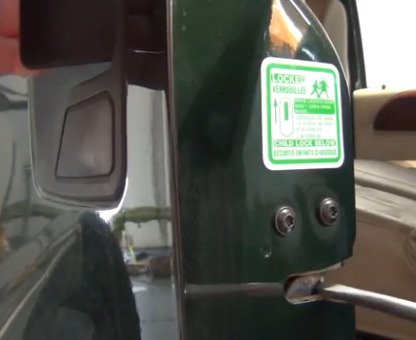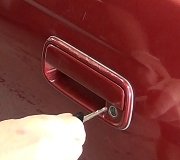Okay, here's what I put together. The first diagram, (suitable for framing), is the entire window system. The second diagram is just the left rear circuit. Everything else is chopped off to reduce confusion.
You have this mostly correct.
" The main connection on this harness has five wires on it. A black wire, a blue wire, a yellow wire, a green wire, and a red wire".
That's connector "KN1".
"The window up and down switch connection has two wires to it, a purple wire and the OTHER red wire red wire (re: the above two red wires). Those two wires have continuity from the window motor connection to the window up and down switch"
The third diagram shows what you just measured. The red arrows are pointing to the red wire at the motor and at the switch. Same with the purple arrows for the purple wire.
A lot of confusion is from that red wire to the motor. It would have been nice if they had used any other color. This is where you went off the rails.
Rather than comment on each test you did, it might make more sense with the fourth diagram. They didn't show the driver's switch for your model, so these are for a '98 Jeep. Other than the little lights in the switches, this is a very basic and common circuit.
In the fifth diagram, I added the green circuit that matches the red motor wire of your circuit. The important point in these diagrams is all of the switches are released.
Starting at the motor, follow the wire through the left rear "down" switch, through two connectors to the driver's door and switch, through the driver's "LR down" switch, back through the hinges and another connector, then to ground on the body.
In the sixth diagram, the blue circuit follows a similar path through the left rear "up" switch, through two connectors, to the driver's door and switch, through the driver's "LR up" switch, then to ground just like the red circuit.
Everywhere you measure in these two circuits will have continuity to ground, but only when everything is plugged in. This is why this circuit confuses so many people. Everything seems to be shorted.
The magic starts when one switch is pressed in diagram seven. The red line shows the 12 volt supply circuit. Follow this through the lockout switch at the far right of the driver's switch, then out to the three passenger switches. In the left rear switch, the "down" switch is pressed. Note that the "up" switch is still released and is still grounded. The "down" switch has moved away from the ground contact, and is touching the 12 volt contact. That 12 volts appears on one motor terminal. The other motor terminal is still grounded. Current always must have a complete path from and back to the battery to flow. The green line shows the positive half of the circuit, and the blue line in the sixth diagram shows the ground side. The window rolls down.
Moving the switch the other way leaves the "down" switch released and grounded, but puts the 12 volts on the left side of the motor. The motor runs the other way. This same switching can be done at the driver's switch.
Another important point is regardless which switch is pressed, there are four sets of contacts current must flow through for the motor to run. That's the one pressed switch and the three released switches. Also, the part of the switch with the ground contact can be arced or pitted causing the circuit to not work. That means either one can cause the problem when either one is pressed.
To say that a less confusing way, the window could work both ways from the driver's switch, but the "down" function is dead from the left rear switch, but it's the driver's switch that is at fault. The working switch can be the bad one.
When trying to run the window down, if you connect the battery with everything connected, remember both wires go to ground through the four released switches. That puts a dead short across the battery, and lots of sparks and excitement. You have to break the circuit someplace so that short isn't there.
Getting back to your circuit, you already have everything disconnected, so those wires aren't grounded, shorted, or connected. You're free to connect the battery. Since you were able to get to the "K3" motor connector, you can connect the battery's positive and negative wires to those two terminals on the motor if you can get to them. Change the polarity if the motor tries to run the wrong way.
Another way is to plug the "K3" connector back into the motor, then connect the battery wires to the green and yellow wires in the "KN1" connector. You'll be mimicking what the driver's switch does when a switch is pressed. You can also use the red and purple wires. The switch doesn't have to be plugged in to use the red and purple wires. It does when using the green and yellow wires.
There's no actual ground wire with the "KN1" body connector unplugged. The red 12 volt wire coming from the fuse can be used, but doing so is overly-complicated because you would have to press a switch and move the other wire around. If the goal is just to get the window down so you can work on the door, it's far easier to use the green and yellow or the red and purple wires.
Images (Click to make bigger)
Thursday, May 11th, 2023 AT 2:02 PM





































